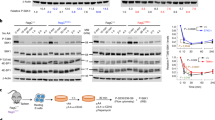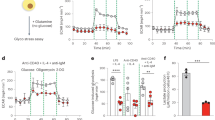Abstract
Mice deficient in sphingosine 1-phosphate receptor type 2 (S1P2) develop diffuse large B cell lymphoma. However, the role of S1P2 in normal germinal center (GC) physiology is unknown. Here we show that S1P2-deficient GC B cells outgrew their wild-type counterparts in chronically established GCs. We found that antagonism of the kinase Akt mediated by S1P2 and its downstream mediators Gα12, Gα13 and p115RhoGEF regulated cell viability and was required for growth control in chronically proliferating GCs. Moreover, S1P2 inhibited GC B cell responses to follicular chemoattractants and helped confine cells to the GC. In addition, S1P2 overexpression promoted the centering of activated B cells in the follicle. We suggest that by inhibiting Akt activation and migration, S1P2 helps restrict GC B cell survival and localization to an S1P-low niche at the follicle center.
This is a preview of subscription content, access via your institution
Access options
Subscribe to this journal
Receive 12 print issues and online access
$209.00 per year
only $17.42 per issue
Buy this article
- Purchase on Springer Link
- Instant access to full article PDF
Prices may be subject to local taxes which are calculated during checkout







Similar content being viewed by others
References
MacLennan, I.C.M. Germinal Centers. Annu. Rev. Immunol. 12, 117–139 (1994).
Allen, C.D., Okada, T. & Cyster, J.G. Germinal-center organization and cellular dynamics. Immunity 27, 190–202 (2007).
Fagarasan, S., Kawamoto, S., Kanagawa, O. & Suzuki, K. Adaptive immune regulation in the gut: T cell-dependent and T cell-independent IgA synthesis. Annu. Rev. Immunol. 28, 243–273 (2010).
Goodnow, C.C., Vinuesa, C.G., Randall, K.L., Mackay, F. & Brink, R. Control systems and decision making for antibody production. Nat. Immunol. 11, 681–688 (2010).
Vikstrom, I. et al. Mcl-1 is essential for germinal center formation and B cell memory. Science 330, 1095–1099 (2010).
Allen, C.D. et al. Germinal center dark and light zone organization is mediated by CXCR4 and CXCR5. Nat. Immunol. 5, 943–952 (2004).
Pereira, J.P., Kelly, L.M., Xu, Y. & Cyster, J.G. EBI2 mediates B cell segregation between the outer and centre follicle. Nature 460, 1122–1126 (2009).
Pereira, J.P., Kelly, L.M. & Cyster, J.G. Finding the right niche: B cell migration in the early phases of T-dependent antibody responses. Int. Immunol. 22, 413–419 (2010).
Schwab, S.R. & Cyster, J.G. Finding a way out: lymphocyte egress from lymphoid organs. Nat. Immunol. 8, 1295–1301 (2007).
Venkataraman, K. et al. Vascular endothelium as a contributor of plasma sphingosine 1-phosphate. Circ. Res. 102, 669–676 (2008).
Schwab, S.R. et al. Lymphocyte sequestration through S1P lyase inhibition and disruption of S1P gradients. Science 309, 1735–1739 (2005).
Pappu, R. et al. Promotion of lymphocyte egress into blood and lymph by distinct sources of sphingosine-1-phosphate. Science 316, 295–298 (2007).
Pham, T.H. et al. Lymphatic endothelial cell sphingosine kinase activity is required for lymphocyte egress and lymphatic patterning. J. Exp. Med. 207, 17–27 (2010).
Spiegel, S. & Milstien, S. Sphingosine-1-phosphate: an enigmatic signalling lipid. Nat. Rev. Mol. Cell Biol. 4, 397–407 (2003).
Luckey, C.J. et al. Memory T and memory B cells share a transcriptional program of self-renewal with long-term hematopoietic stem cells. Proc. Natl. Acad. Sci. USA 103, 3304–3309 (2006).
Kono, M. et al. The sphingosine-1-phosphate receptors S1P1, S1P2, and S1P3 function coordinately during embryonic angiogenesis. J. Biol. Chem. 279, 29367–29373 (2004).
Cattoretti, G. et al. Targeted disruption of the S1P2 sphingosine 1-phosphate receptor gene leads to diffuse large B-cell lymphoma formation. Cancer Res. 69, 8686–8692 (2009).
Ishii, I., Fukushima, N., Ye, X. & Chun, J. Lysophospholipid receptors: signaling and biology. Annu. Rev. Biochem. 73, 321–354 (2004).
Ruppel, K.M. et al. Essential role for Gα13 in endothelial cells during embryonic development. Proc. Natl. Acad. Sci. USA 102, 8281–8286 (2005).
Rieken, S. et al. G12/G13 family G proteins regulate marginal zone B cell maturation, migration, and polarization. J. Immunol. 177, 2985–2993 (2006).
Girkontaite, I. et al. Lsc is required for marginal zone B cells, regulation of lymphocyte motility and immune responses. Nat. Immunol. 2, 855–862 (2001).
Rubtsov, A. et al. Lsc regulates marginal-zone B cell migration and adhesion and is required for the IgM T-dependent antibody response. Immunity 23, 527–538 (2005).
Siehler, S. Regulation of RhoGEF proteins by G12/13-coupled receptors. Br. J. Pharmacol. 158, 41–49 (2009).
Ming, X.F. et al. Rho GTPase/Rho kinase negatively regulates endothelial nitric oxide synthase phosphorylation through the inhibition of protein kinase B/Akt in human endothelial cells. Mol. Cell. Biol. 22, 8467–8477 (2002).
Wolfrum, S. et al. Inhibition of Rho-kinase leads to rapid activation of phosphatidylinositol 3-kinase/protein kinase Akt and cardiovascular protection. Arterioscler. Thromb. Vasc. Biol. 24, 1842–1847 (2004).
Sanchez, T. et al. PTEN as an effector in the signaling of antimigratory G protein-coupled receptor. Proc. Natl. Acad. Sci. USA 102, 4312–4317 (2005).
Schuppel, M., Kurschner, U., Kleuser, U., Schafer-Korting, M. & Kleuser, B. Sphingosine 1-phosphate restrains insulin-mediated keratinocyte proliferation via inhibition of Akt through the S1P2 receptor subtype. J. Invest. Dermatol. 128, 1747–1756 (2008).
Li, Z. et al. Regulation of PTEN by Rho small GTPases. Nat. Cell Biol. 7, 399–404 (2005).
Ahmed, N.N., Grimes, H.L., Bellacosa, A., Chan, T.O. & Tsichlis, P.N. Transduction of interleukin-2 antiapoptotic and proliferative signals via Akt protein kinase. Proc. Natl. Acad. Sci. USA 94, 3627–3632 (1997).
Engelman, J.A. Targeting PI3K signalling in cancer: opportunities, challenges and limitations. Nat. Rev. Cancer 9, 550–562 (2009).
Skoura, A. & Hla, T. Regulation of vascular physiology and pathology by the S1P2 receptor subtype. Cardiovasc. Res. 82, 221–228 (2009).
Michaud, J., Im, D.S. & Hla, T. Inhibitory role of sphingosine 1-phosphate receptor 2 in macrophage recruitment during inflammation. J. Immunol. 184, 1475–1483 (2010).
Allen, C.D., Okada, T., Tang, H.L. & Cyster, J.G. Imaging of germinal center selection events during affinity maturation. Science 315, 528–531 (2007).
Browning, J.L. Inhibition of the lymphotoxin pathway as a therapy for autoimmune disease. Immunol. Rev. 223, 202–220 (2008).
Pham, T.H., Okada, T., Matloubian, M., Lo, C.G. & Cyster, J.G. S1P1 receptor signaling overrides retention mediated by Gαi–coupled receptors to promote T cell egress. Immunity 28, 122–133 (2008).
Sinha, R.K., Park, C., Hwang, I.Y., Davis, M.D. & Kehrl, J.H. B lymphocytes exit lymph nodes through cortical lymphatic sinusoids by a mechanism independent of sphingosine-1-phosphate-mediated chemotaxis. Immunity 30, 434–446 (2009).
Ma, X.M. & Blenis, J. Molecular mechanisms of mTOR-mediated translational control. Nat. Rev. Mol. Cell Biol. 10, 307–318 (2009).
Mamane, Y. et al. Epigenetic activation of a subset of mRNAs by eIF4E explains its effects on cell proliferation. PLoS ONE 2, e242 (2007).
Wendel, H.G. et al. Dissecting eIF4E action in tumorigenesis. Genes Dev. 21, 3232–3237 (2007).
Hsieh, A.C. et al. Genetic dissection of the oncogenic mTOR pathway reveals druggable addiction to translational control via 4EBP-eIF4E. Cancer Cell 17, 249–261 (2010).
Wieman, H.L., Wofford, J.A. & Rathmell, J.C. Cytokine stimulation promotes glucose uptake via phosphatidylinositol-3 kinase/Akt regulation of Glut1 activity and trafficking. Mol. Biol. Cell 18, 1437–1446 (2007).
Misra, R.S. et al. Gαq-containing G proteins regulate B cell selection and survival and are required to prevent B cell-dependent autoimmunity. J. Exp. Med. 207, 1775–1789 (2010).
Omori, S.A. et al. Regulation of class-switch recombination and plasma cell differentiation by phosphatidylinositol 3-kinase signaling. Immunity 25, 545–557 (2006).
Suzuki, A. et al. Critical roles of Pten in B cell homeostasis and immunoglobulin class switch recombination. J. Exp. Med. 197, 657–667 (2003).
Schenck, A. et al. The endosomal protein Appl1 mediates Akt substrate specificity and cell survival in vertebrate development. Cell 133, 486–497 (2008).
Ishii, M., Kikuta, J., Shimazu, Y., Meier-Schellersheim, M. & Germain, R.N. Chemorepulsion by blood S1P regulates osteoclast precursor mobilization and bone remodeling in vivo. J. Exp. Med. 207, 2793–2798 (2010).
Carmona-Fontaine, C. et al. Contact inhibition of locomotion in vivo controls neural crest directional migration. Nature 456, 957–961 (2008).
Francis, S.A., Shen, X., Young, J.B., Kaul, P. & Lerner, D.J. Rho GEF Lsc is required for normal polarization, migration, and adhesion of formyl-peptide-stimulated neutrophils. Blood 107, 1627–1635 (2006).
Dengler, H.S. et al. Distinct functions for the transcription factor Foxo1 at various stages of B cell differentiation. Nat. Immunol. 9, 1388–1398 (2008).
Reif, K. et al. Balanced responsiveness to chemoattractants from adjacent zones determines B-cell position. Nature 416, 94–99 (2002).
Acknowledgements
We thank N. Danial (Dana-Farber) for Bad-deficient bone marrow; K. Rajewsky (Children's Hospital and Immune Disease Institute, Harvard) for mice expressing the Cr2-Cre transgene; J. Browning (Biogen Idec) for lymphotoxin-β receptor–Fc fusion protein; J. An for help with the mouse colony; and S. Schwab for critical reading of the manuscript. Supported by the National Science Foundation (J.A.G.), Howard Hughes Medical Institute (J.G.C.) and the US National Institutes of Health (Intramural Research Program; National Institute of Diabetes and Digestive and Kidney Diseases (R.L.P.); HL65590 and HL44907 to S.R.C.; and AI45073 to J.G.C.).
Author information
Authors and Affiliations
Contributions
J.A.G., B.C. and J.G.C. designed the experiments; J.A.G. did most of the experiments; B.C. did some of the early experiments; K.S. and J.A.G. did the imaging experiments; C.D.C.A. and Y.X. did the initial gene-expression analysis; T.H.S. and J.A.G. did the experiments with PTEN inhibitor; L.D.W. and S.R.C. generated Gα12-deficient mice; D.P. and S.R.C. generated Gna12−/−Gna13f/fMx1-Cre bone marrow; R.L.P. generated S1P2-deficient mice; J.A.G., K.S., B.C. and J.G.C. analyzed the data; and J.A.G. and J.G.C. wrote the paper.
Corresponding author
Ethics declarations
Competing interests
The authors declare no competing financial interests.
Supplementary information
Supplementary Text and Figures
Supplementary Figures 1–8 (PDF 1607 kb)
Supplementary Video 1
Movement of S1pr2+/+ Hy10 GC B cells within FDC network. (MPG 5540 kb)
Supplementary Video 2
Movement of S1pr2−/− Hy10 GC B cells around the perimeter of the FDC network. (MPG 5490 kb)
Supplementary Video 3
Tracks of wild-type and S1pr2−/− Hy10 GC B cells in and around PE-IC-labeled FDC network. (MPG 20721 kb)
Supplementary Video 4
Movement of S1pr2+/+ Hy10 GC B cells within a GC surrounded by an excess of labeled follicular B cells. (MPG 9826 kb)
Supplementary Video 5
Movement of S1pr2−/− Hy10 GC B cells around the perimeter of a GC surrounded by an excess of labeled follicular B cells. (MPG 8424 kb)
Supplementary Video 6
Tracks of wild-type and S1pr2−/− Hy10 GC B cells with respect to the surface of the GC, defined by the distribution of wild-type follicular and GC B cells. (MPG 25770 kb)
Rights and permissions
About this article
Cite this article
Green, J., Suzuki, K., Cho, B. et al. The sphingosine 1-phosphate receptor S1P2 maintains the homeostasis of germinal center B cells and promotes niche confinement. Nat Immunol 12, 672–680 (2011). https://doi.org/10.1038/ni.2047
Received:
Accepted:
Published:
Issue Date:
DOI: https://doi.org/10.1038/ni.2047
This article is cited by
-
Altered pathways and targeted therapy in double hit lymphoma
Journal of Hematology & Oncology (2022)
-
Supplying the trip to antibody production—nutrients, signaling, and the programming of cellular metabolism in the mature B lineage
Cellular & Molecular Immunology (2022)
-
Loss of AID exacerbates the malignant progression of CLL
Leukemia (2022)
-
Postnatal deletion of Spns2 prevents neuroinflammation without compromising blood vascular functions
Cellular and Molecular Life Sciences (2022)
-
OCT2 pre-positioning facilitates cell fate transition and chromatin architecture changes in humoral immunity
Nature Immunology (2021)



